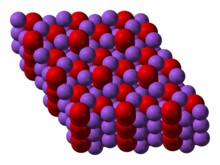
| |

| |

| |
| Names | |
|---|---|
| IUPAC name
Sodium peroxide
| |
| Other names
Flocool
Solozone Disodium peroxide | |
| Identifiers | |
3D model (JSmol)
|
|
| ChemSpider | |
| ECHA InfoCard | 100.013.828 |
| EC Number |
|
PubChem CID
|
|
| RTECS number |
|
| UNII | |
| UN number | 1504 |
CompTox Dashboard (EPA)
|
|
| |
| |
| Properties | |
| Na2O2 | |
| Molar mass | 77.98 g/mol |
| Appearance | yellow to white powder |
| Density | 2.805 g/cm3 |
| Melting point | 460 °C (860 °F; 733 K) (decomposes) |
| Boiling point | 657 °C (1,215 °F; 930 K) (decomposes) |
| Reacts | |
| Solubility | Soluble in acid Insoluble in base Reacts with ethanol |
| −28.10·10−6 cm3/mol | |
| Structure | |
| hexagonal | |
| Thermochemistry | |
Heat capacity (C)
|
89.37 J/(mol·K) |
Std molar
entropy (S⦵298) |
95 J/(mol·K)[1] |
Std enthalpy of
formation (ΔfH⦵298) |
−515 kJ·mol−1[1] |
Gibbs free energy (ΔfG⦵)
|
−446.9 kJ/mol |
| Hazards | |
| Occupational safety and health (OHS/OSH): | |
Main hazards
|
caustic |
| GHS labelling: | |
 
| |
| Danger | |
| H271, H314 | |
| P210, P220, P221, P260, P264, P280, P283, P301+P330+P331, P303+P361+P353, P304+P340, P305+P351+P338, P306+P360, P310, P321, P363, P370+P378, P371+P380+P375, P405, P501 | |
| NFPA 704 (fire diamond) | |
| Flash point | Non-flammable |
| Safety data sheet (SDS) | External MSDS |
| Related compounds | |
Other cations
|
Lithium peroxide Potassium peroxide Rubidium peroxide Caesium peroxide |
| Sodium oxide Sodium superoxide Sodium ozonide | |
Related compounds
|
Sodium hydroxide Hydrogen peroxide |
Except where otherwise noted, data are given for materials in their standard state (at 25 °C [77 °F], 100 kPa).
| |
Sodium peroxide is an inorganic compound with the formula Na2O2. This yellowish solid is the product of sodium ignited in excess oxygen.[3] It is a strong base. This metal peroxide exists in several hydrates and peroxyhydrates including Na2O2·2H2O2·4H2O, Na2O2·2H2O, Na2O2·2H2O2, and Na2O2·8H2O.[4] The octahydrate, which is simple to prepare, is white, in contrast to the anhydrous material.[5]
- ^ a b Zumdahl, Steven S. (2009). Chemical Principles 6th Ed. Houghton Mifflin Company. p. A23. ISBN 978-0-618-94690-7.
- ^ "Hazard Rating Information for NFPA Fire Diamonds". Archived from the original on 2004-09-04.
- ^ Greenwood, Norman N.; Earnshaw, Alan (1984). Chemistry of the Elements. Oxford: Pergamon Press. p. 98. ISBN 978-0-08-022057-4.
- ^ Harald Jakob, Stefan Leininger, Thomas Lehmann, Sylvia Jacobi, Sven Gutewort. "Peroxo Compounds, Inorganic". Ullmann's Encyclopedia of Industrial Chemistry, 2007, Wiley-VCH, Weinheim. doi:10.1002/14356007.a19_177.pub2.
- ^ Cite error: The named reference
ISwas invoked but never defined (see the help page).
